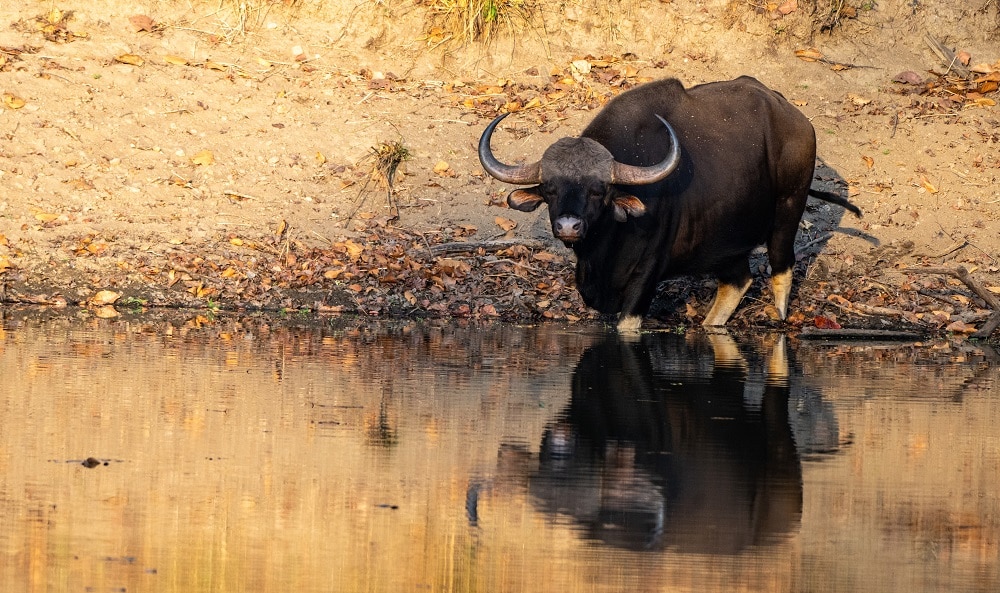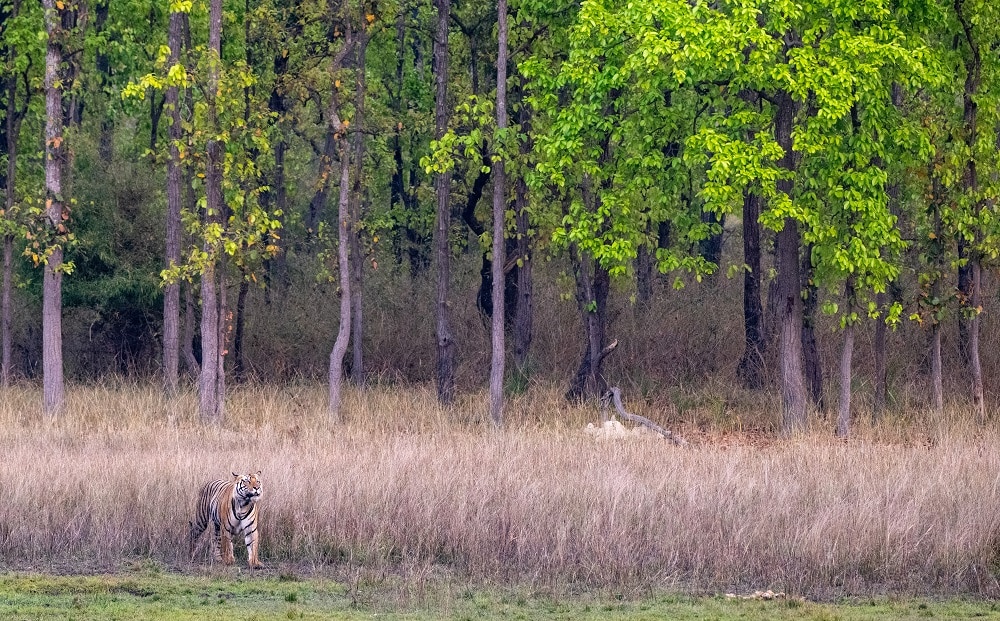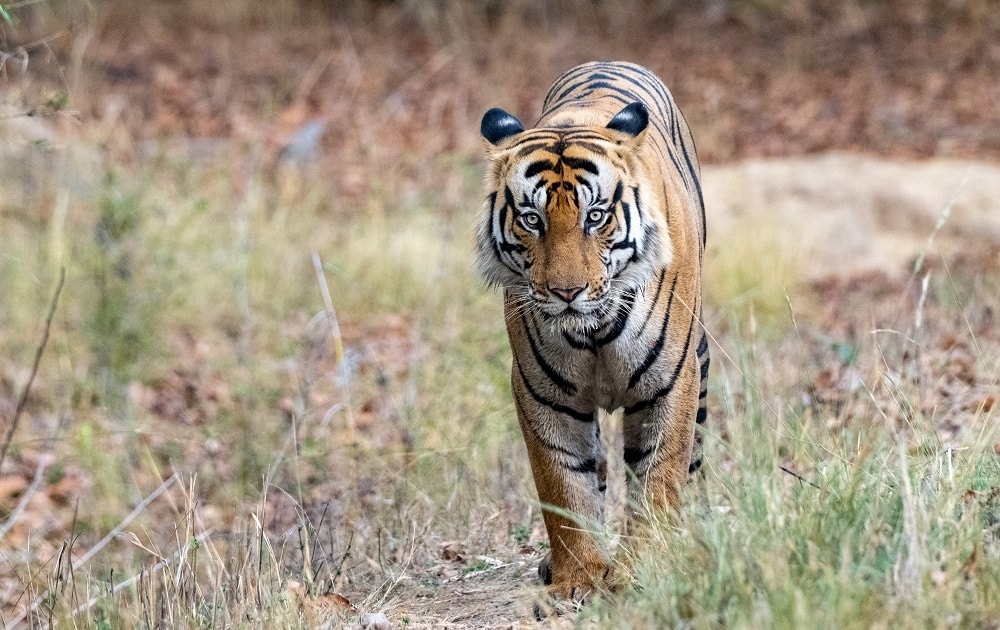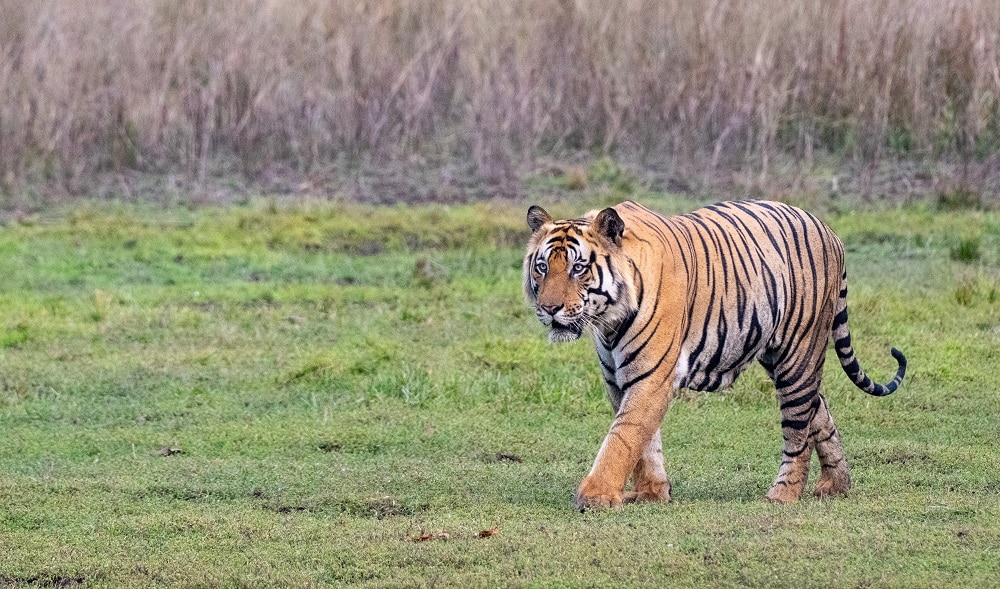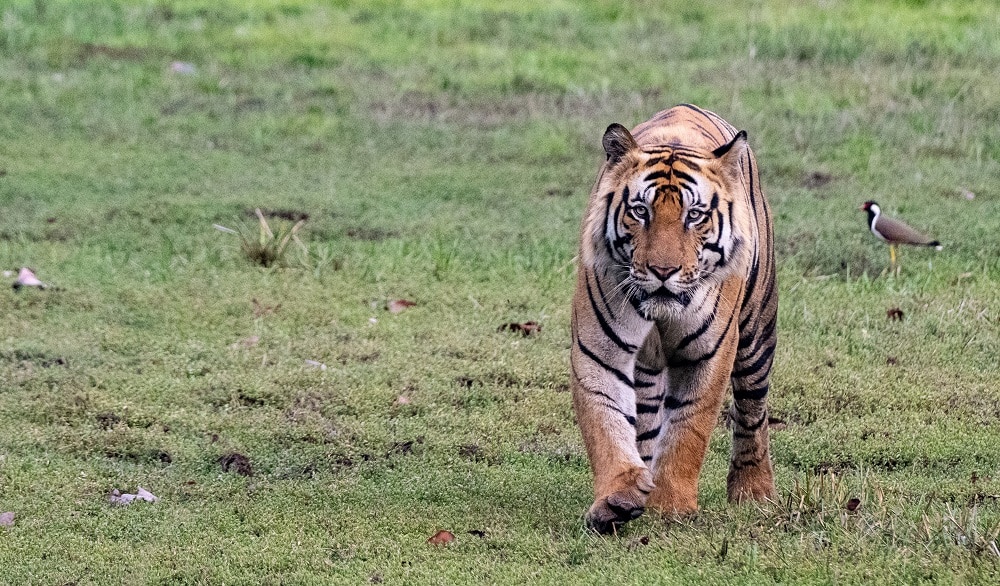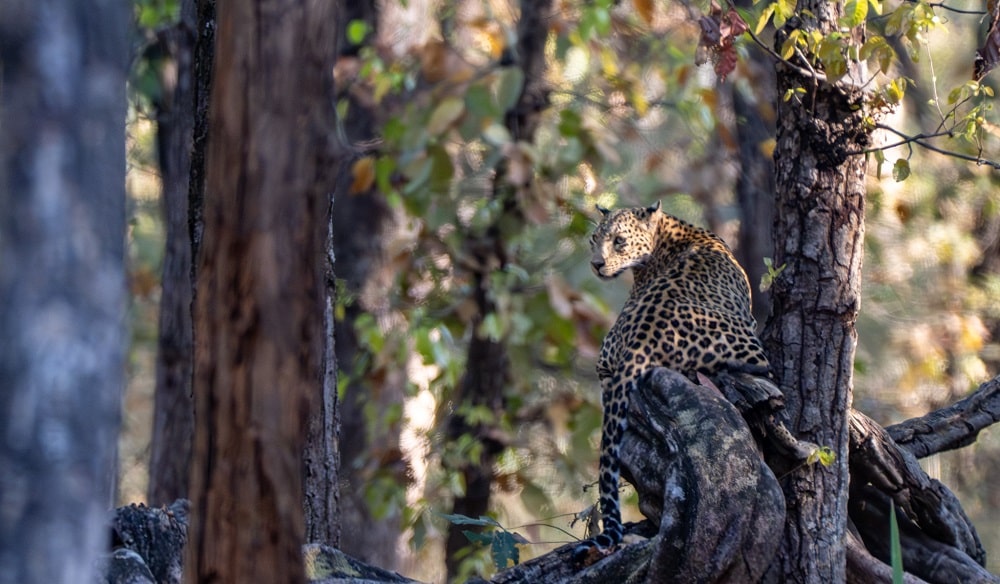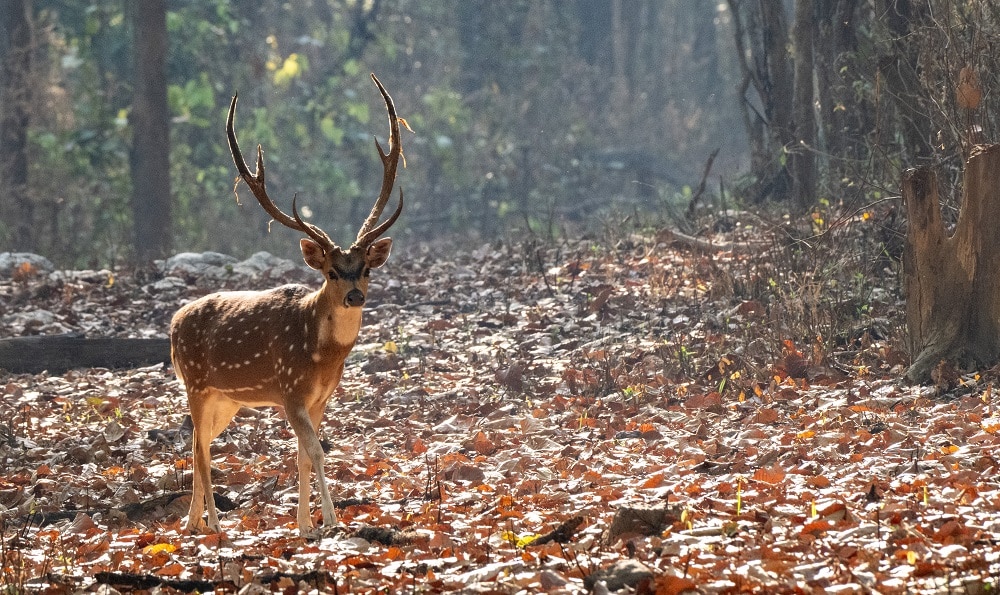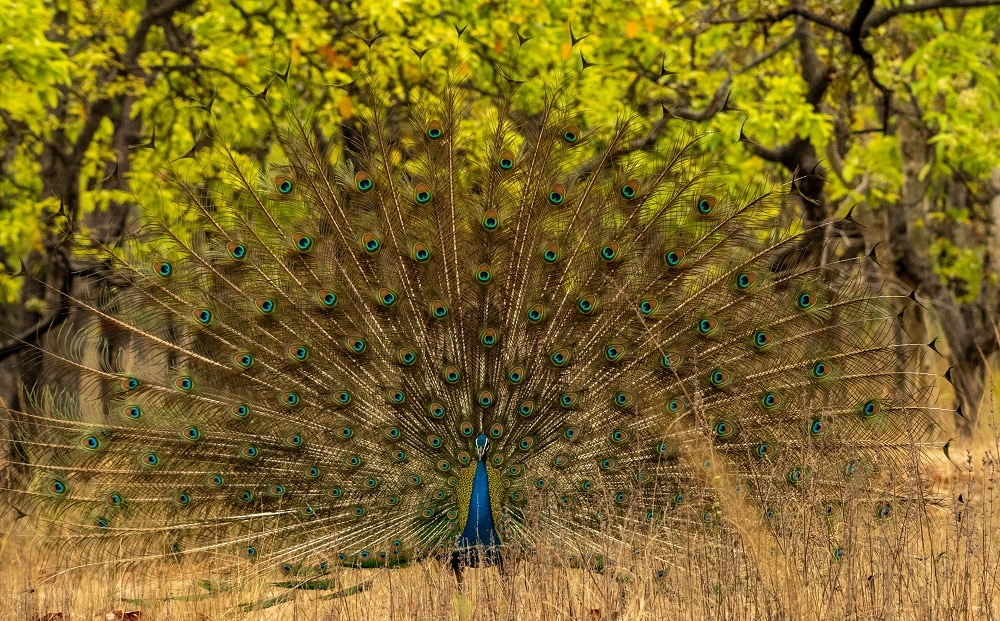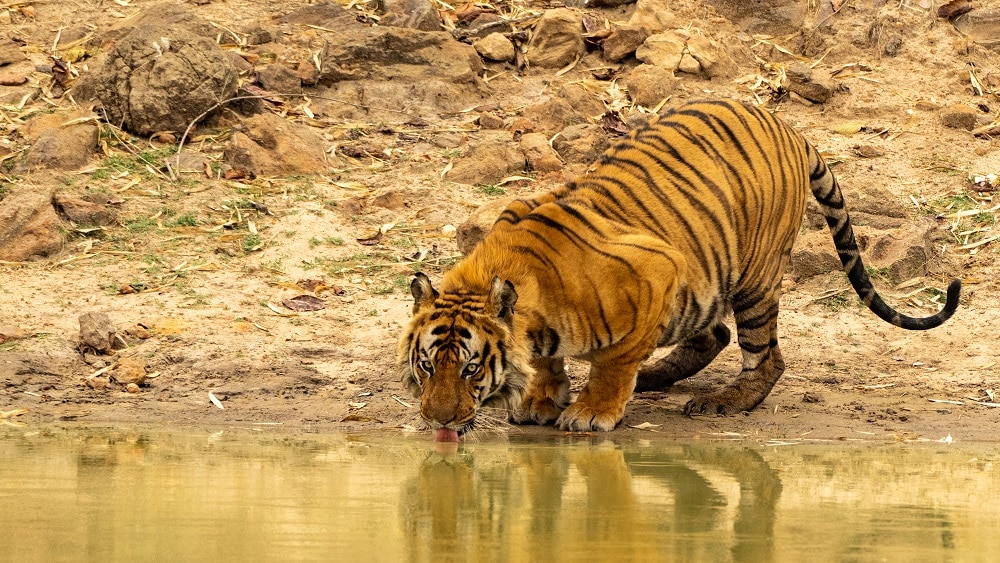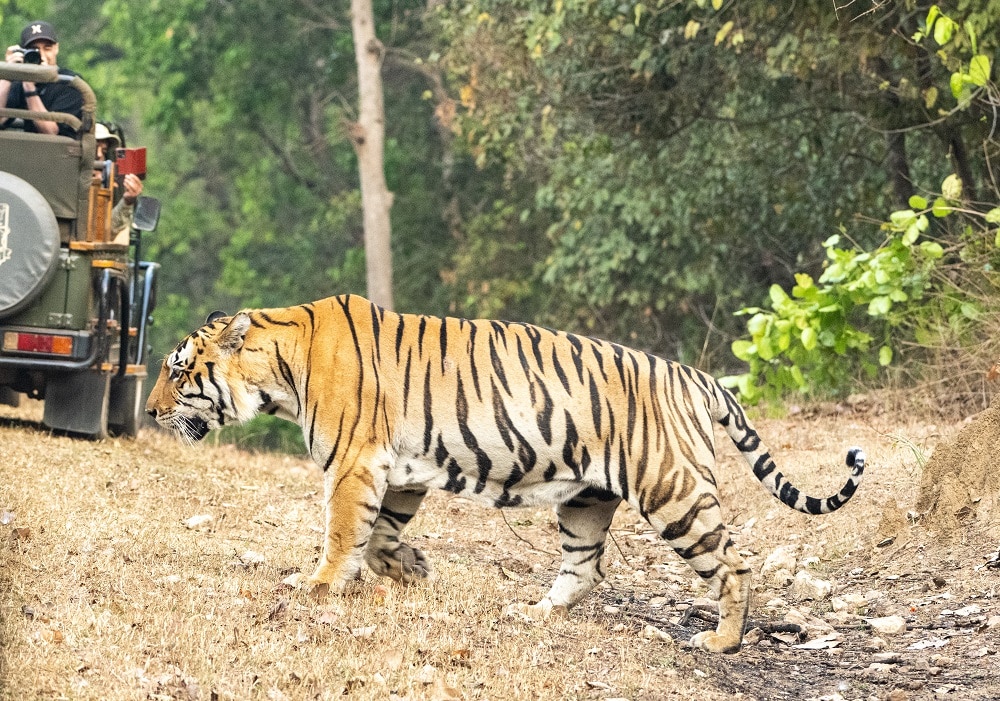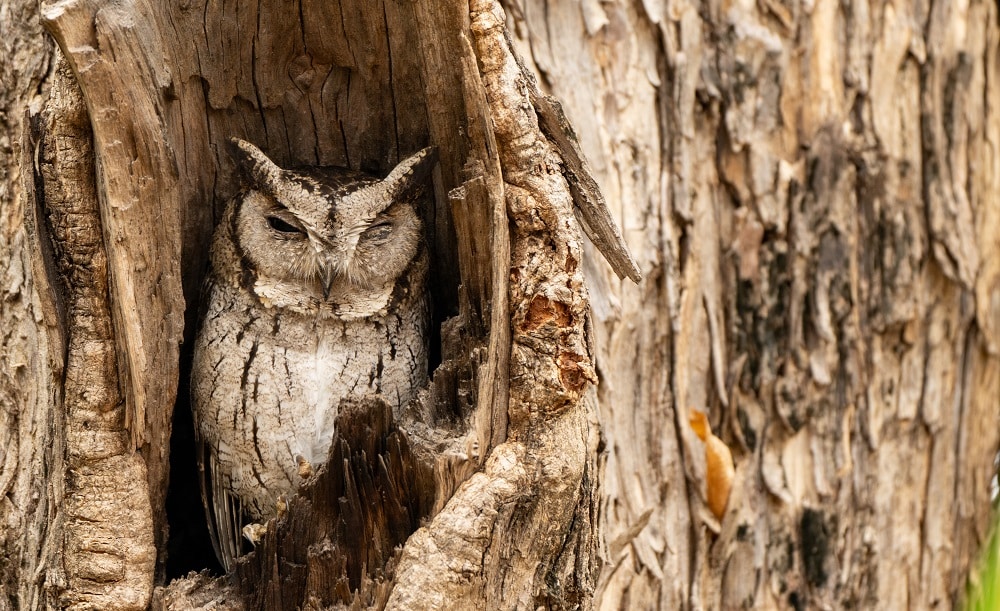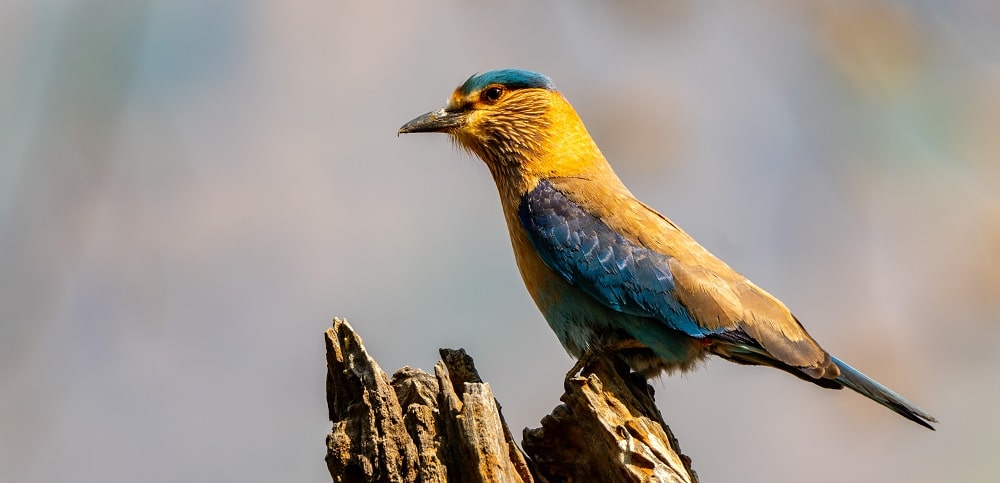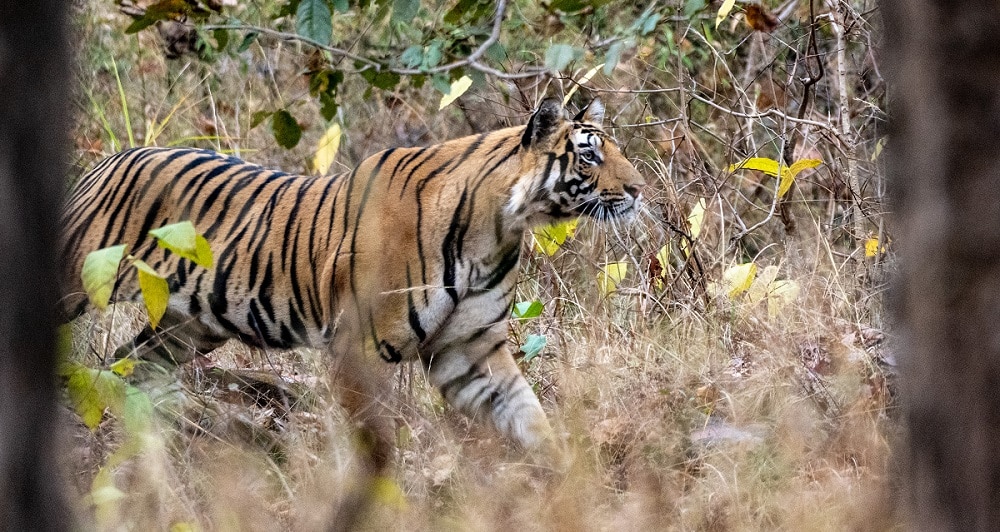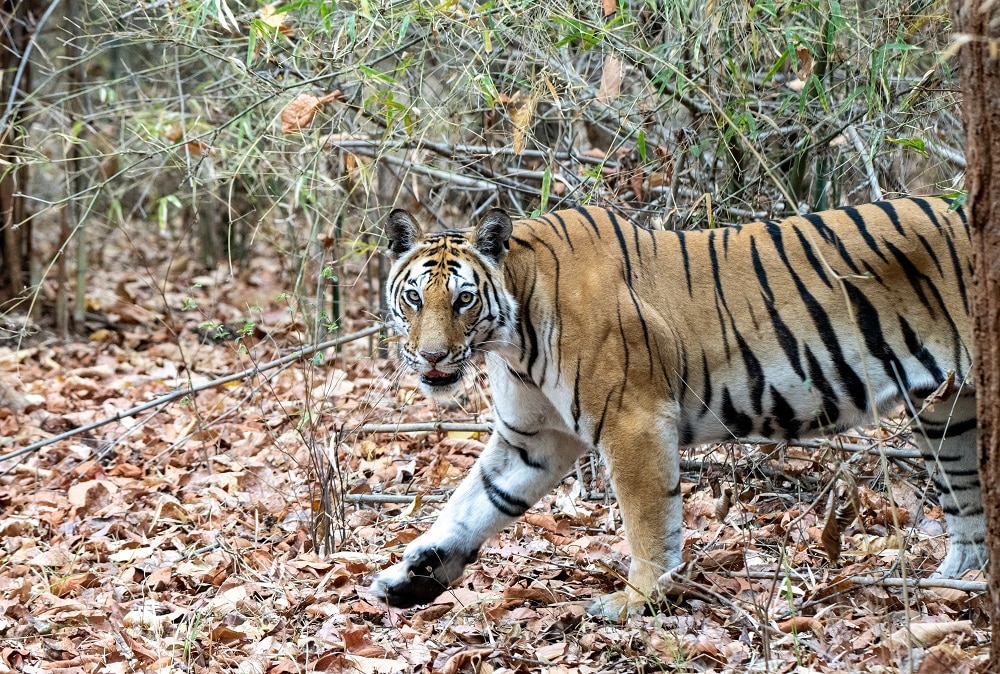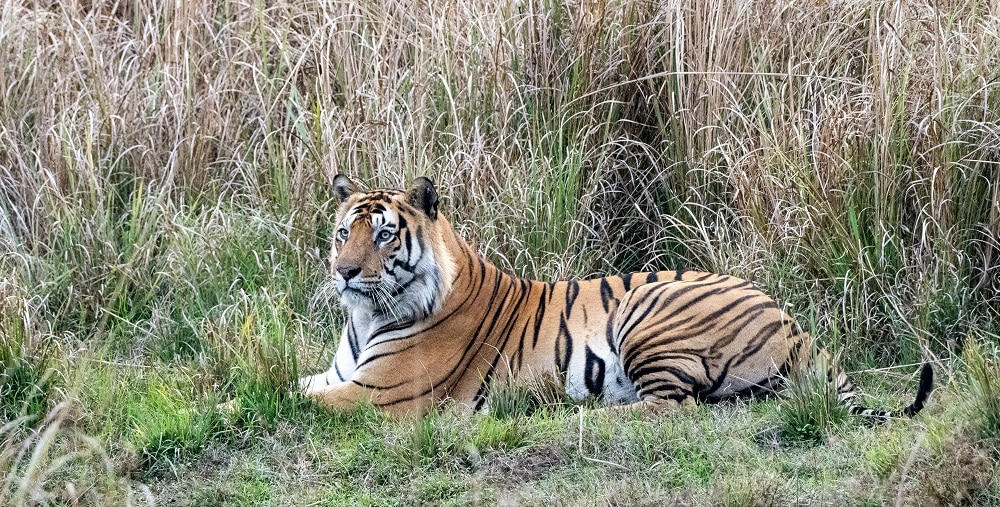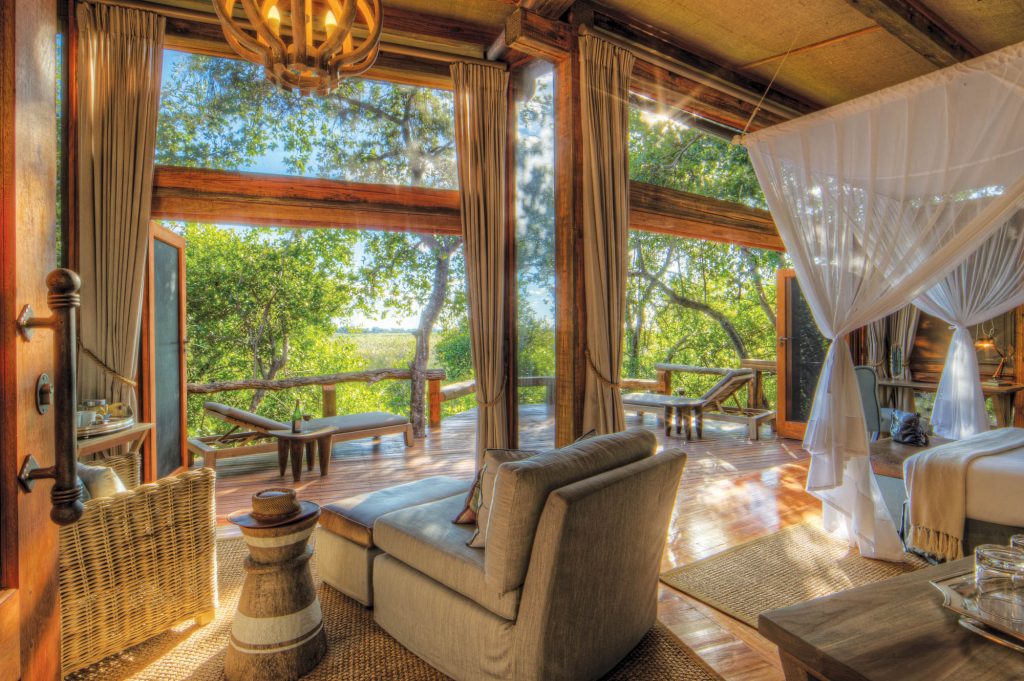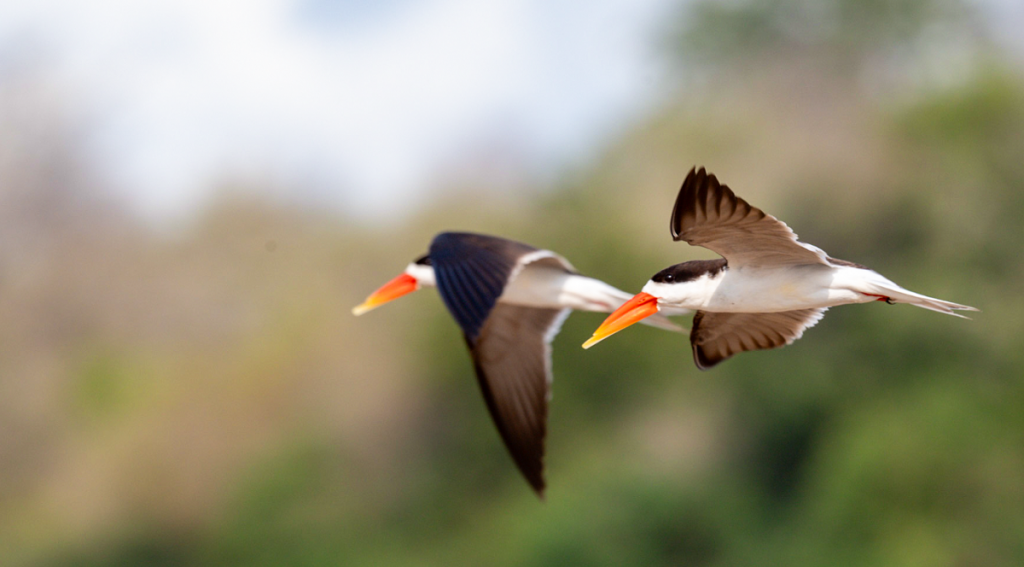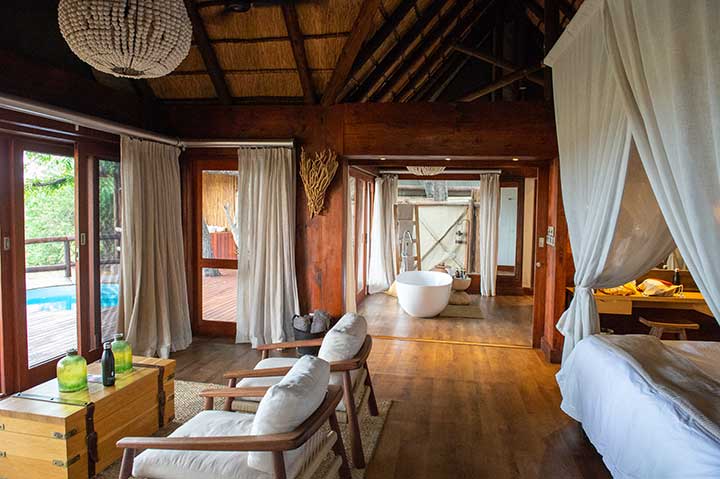Making the Most of an Indian Tiger Safari
Tiger! Tiger! Tiger! A Bengal tiger sighting in India is almost always announced with this three word phrase, fraught with all of the excitement, wonder, admiration and sheer star power engendered by this magnificent creature.
Looking for a tiger in a dense sal forest in Madhya Pradesh state is as much art as it is science. A mix of visible and audible clues, behavioral patterns, prediction, intuition and luck. Observing how the local guides and naturalists track and find tigers – by watching them at work – is part of the fun. The process involves sometimes long drives along invariably bumpy, dusty roads, often stopping – usually at crossroads – to listen for alarm calls of spotted and sambar deer and langur monkeys. The camp naturalist guide and the forest guide – as well as the driver – will look for and study tiger pug marks (paw prints) and analyse them. They will also gather intel from other guides encountered along the way and by way of text or phone messages.
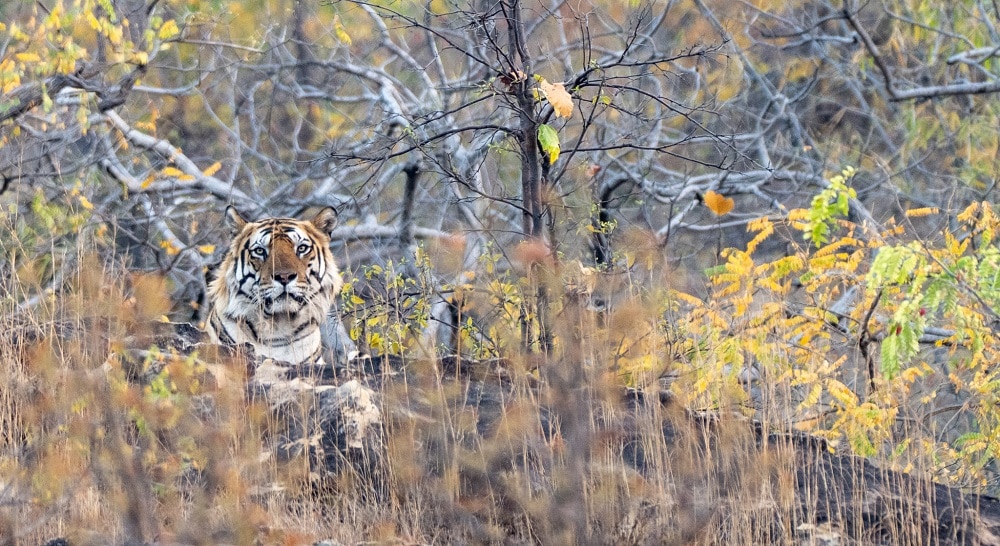
They will put all of this together within the context of recent sightings, established habits and movements of tigers known to be present in the area and seasonal patterns such as finding tigers close to and sometimes in water in the hotter months. And then, often suddenly and seemingly miraculously, it happens. Tiger! Tiger! Tiger!
The participants on one of our small group trips in March experienced this in the most memorable and striking manner on their very first day in Bandhavgahr National Park. Seeing their first ever tiger in the most perfect manner. Initially we had just a glimpse of the large striped cat lying down in thick grass. I wondered if I should even take the big camera out of the bag. This was going to be a nothing event. Was I ever wrong!
Everything changed in a matter of seconds when the tiger caught sight of and started stalking a huge male gaur, sometimes referred to as the Indian bison. Actually much bigger than a bison and equipped with an ominously dangerous looking set of horns, there was practically zero chance of the solitary tiger attacking and overpowering the gaur. At that moment, it didn’t matter. The tiger pretended to be deadly serious and we were only too happy to let it pretend.
Watching the sinewy form of the tiger as it slowly crept in the direction of the guar was the stuff of wildlife documentaries. And we were in it with ringside seats. It almost didn’t matter when – predictably – the tiger gave up on the pursuit and started moving from our left to our right, still partially hidden in tall grass.
As if a dinner bell had been rung, all the safari vehicles took off in clouds of dust, with even the least experienced observer knowing exactly what would come next. The tiger was going to emerge in an open area perhaps a 100 meters or so further along the road. Not three minutes later, it happened. In full view of practically everyone who had a permit for Zone 1 in Bandhavgarh that afternoon, one of the reserve’s superstar dominant males – Bajrang – emerged into the open, barely meters away from his awestruck observers.
In near perfect ‘golden hour’ light the huge tiger majestically strode towards and then right by us. I was so excited I had to remind myself to keep the animal’s feet in the frame. And Bajrang was far from being my first tiger. Such is the impact these gorgeous creatures have on humans. As if one, the adoring crowd experienced the heart-stopping, mesmerizing moment with hardly a word being uttered. No one on our jeep – or anyone in the cars around us – will ever forget that moment, that animal, that experience. Out there in the jungle, confidently strolling around, master of its own domain, a tiger is so much bigger, stronger, more beautiful and more impressive than one could ever imagine.
It is not going to be like Africa
Finding and seeing tigers in India is beyond thrilling, but an African safari it is not. At least not the version of the African safari we’ve grown accustomed to. Those being safaris operated in private game reserves with very few vehicles around, with a high degree of exclusivity and with practically all the guides operating within the constraints of a strict code of conduct.
For example, on safari in Africa it is considered unethical at best to drive into someone’s photo shot. You apologize and get out of the way. In India’s tiger reserves in Madhya Pradesh state, you can bank on someone parking right in front of you if there is even the tiniest bit of space to squeeze into. Matter of fact, it happens quite often without so much as a sidelong glance.
In Africa’s private game reserves and concessions observing and capturing photos and videos of a leopard is a quiet, almost hushed experience. In India? It’s a participation sport with constant and often loud banter between guides, drivers and guests.
In most of the Madhya Pradesh tiger reserves a flotilla of small, open safari vehicles converge on high profile sightings, sometimes three deep and often just inches from each other. Fortunately the total number of vehicles is controlled with a finite number of permits being issued for specific zones per day. Some areas within tiger reserves – such as the Bori Wildlife Sanctuary bordering Satpura National Park – are further away from the tourist hotspots and offer a quieter, more relaxed wildlife-viewing experience.
In most of the popular tiger reserves, the safari experience is boisterous and very much a free for all. Much like India itself. Stick around for a few minutes and a converted bus or truck with up to 18 excited passengers will show up, often filled with local family groups including young kids, all keen to see their first tiger in the wild. Such a wonderful harbinger for the future of wildlife in India.
Noticeably, less than 10 percent of the visitors to the Indian tiger reserves are from abroad. The vast majority are Indian – both local residents of Madhya Pradesh state and from elsewhere such as Mumbai, Delhi and beyond. Straddling the entire spectrum of Indian society. Some speaking near perfect English, others engaging you with just their smiles or their curious glances. Indian tiger safaris are not just for the privileged few; the Madhya Pradesh State Tourism Department encourages locals to visit the parks with discounted permit fees (about half of what foreign visitors pay) and clearly they are succeeding.
If you can embrace the egalitarian nature of the Indian tiger viewing experience, the give and take, the live and let live attitude which is at the heart of the Indian way of life, then by all means come along on our next trip to India next spring 2026. It’s not exclusive, it’s not private and it has its shortcomings. All of which vanish in a second when you see your first tiger in the wild.
What you will soon realize once there, is that there is an unspoken agreement at work, even when you are ensconced in a scrum of small safari vehicles. Someone might abruptly cut in front of you, but he will be happy to reposition his vehicle to allow you an unobstructed view of the tiger or leopard or whatever may be the focus of attention. Information about sightings is routinely and immediately shared and vehicles (other than ones with full day permits) are required to relocate after 10 minutes. So everyone gets a chance, nobody is shut out and you’ll get some good views and photo opportunities. Not always from the absolute best spot and you might have to get creative to avoid vehicles in the background. As is the case anywhere in India, a bit of patience, a dollop of good will and a smile go a long way.
There will be slow days on a tiger safari
In Africa a slow day on safari is usually interspersed with some sightings of elephants or buffaloes or maybe giraffes and zebras and many different antelopes and gazelles. India’s tiger reserves have only five or six mammals which are common and seen regularly, namely spotted deer, sambar deer, gaur, wild boars and jackals. Barasinga deer, Nilgai antelope and barking deer are also seen in some areas. Compared with Africa, the total number of mammals is relatively low.
So you will almost definitely experience days on safari in India where not much happens: mostly just a lot of driving along dusty, bumpy roads checking known tiger haunts and following up on recent sightings. The guides will stop to listen for alarm calls made by langur monkeys, spotted deer and sambar deer; they will check the terrain for tiger tracks (pug marks as they are referred to in India) and droppings. And they will constantly be exchanging information with other guides and drivers electronically.
Despite their best efforts, some days are bound to be slow and tiger-less. Feeling disappointed is a natural reaction but it’s nobody’s fault and everyone is working as hard as they can to produce sterling sightings. Male tigers have huge territories and the animals move around in real time. Sometimes a thunderstorm or some other weather event or controlled burning (with workers on the edge of the roads) or a tiger census being underway or a bird count or some other unknown factor results in the tigers staying hunkered down.
The payoff for not being overly critical and judgmental or expecting the process or the results to be just like they are in Africa is huge. It comes of course in the shape of a massive striped cat which has no rival in the animal kingdom in terms of sheer star power, visual impact and magnetic presence: the Bengal tiger. Getting a really good look at a tiger in its environment – perhaps in a sal forest in Bandhavgarh or emerging from a teak forest in Satpura, may very well be a life changing experience. One thing is certain: you’ll want to see another one.
People and conservation
A trip to India’s tiger reserves is mostly about seeing tigers and other wildlife but you’ll be sure to come back with memories and experiences well beyond that. Starting with the people. I’m constantly impressed by all the people working in the various reserves, so focused on protecting their wild spaces and the amazing fauna and flora around them. Starting with your dedicated Indian tour leader, you will experience many happy people loving what they do and wanting to share it with visitors.
Our India partner – Encounters Asia – has been closely associated with the success story which is Project Tiger since its inception in 1973. Your presence in India will directly help to protect tigers, by growing the financial impact of responsible tourism in disadvantaged rural communities. Sustainable eco-tourism brings jobs, creates a demand for support services and grows local businesses. All of which act as an incentive for local communities to become engaged in protecting the wildlife and the wilderness.
Some practical hints:
Binoculars
Don’t even think of showing up in an Indian tiger reserve without your own pair of good binoculars – and don’t try to share a pair. Sightings of tigers and leopards are often at a relatively long distance. With good binoculars you’ll have more than satisfactory views, even if the animals are too far away for photographs. Without binoculars you will miss many of the sightings altogether. So buy a good pair of binoculars and familiarize yourself with using them before the trip so that you won’t be fumbling around with focusing or finding something quickly. On a tiger safari, sometimes just seconds can make a difference between seeing something truly spectacular – and missing it altogether.
Photography
Keen photographers, take note: for the same reason as mentioned above (many long distance sightings) bring a long enough telephoto lens, at least 400mm and ideally up to 600mm and 800mm. A 180-600mm or 100-500mm zoom lens also works well.
Be sure to pack a monopod as you’re likely to be shooting into shady forested spots in some reserves such as Bandhavgarh and Kanha, and you’ll need to support the camera to be able to reduce the shutter speed and keep the ISO as low as possible.
Game drive preparation
It will be dusty to very dusty, particularly if you travel from February through April. Take a buff to protect yourself and a bag or cover for your cameras and lenses. There will be water on the vehicles but take your own bottle if you want. Mornings – even as late as early April – can be chilly so be sure to have at least a light jacket or fleece handy. It warms up quickly and by 9 am you’re likely to start peeling off a layer or two. For winter travel – November through January – much more extensive layering is necessary and you’ll be glad to have a heavy, well-insulated hooded jacket, a puffy jacket, good quality gloves and a cold weather beanie at hand.
Driving between national parks
There will be some long drives – mostly around four hours but up to five and a half hours – on asphalt roads to get from one tiger reserve to another. Comfortable compact air-conditioned SUV’s are used, with professional drivers, and top speeds rarely exceed 50 mph. Nonetheless it can be a disconcerting experience due to India’s free-wheeling driving practices, the constant honking, the often narrow, winding roads and the many obstacles and road hazards which have to be avoided. These include cows, domesticated buffalo, dogs, goats, motor bikes, bikes, pedestrians, trucks, buses, other livestock and random objects which may range from wheelbarrows to oxcarts. Comfort stops are made but they can be more than two hours apart. So limit your liquid intake. There are snacks and water in the vehicles. If you are prone to motion sickness, be sure to bring your Dramamine or other medication. The tight turns and repeatedly swaying left and right, with sudden jerks and bumps and unpredictable movement, can trigger nausea. So best to eat light before any road transfer.
Commercial flights
There’s likely to be at least two commercial flights on your tiger safari. On our last three trips the flights were from Delhi to Jabalpur and then Nagpur back to Delhi. Neither of the flights were much longer than an hour and generally speaking we’ve had no issues with the airports, check-in procedures (mostly quick, short lines) or in-flight service and baggage handling. Security is super-tight everywhere and it is important not to pack anything electronic (something which has a battery) in your checked luggage; specifically power banks or lithium-ion or similar batteries. All electronics including cameras, laptops, iPhones, tablets and similar have to be separated from your hand luggage for the pre-boarding security screening process. Allow an additional 20 minutes in your schedule for that purpose. It’s all done in a very professional and courteous manner, but it can be time-consuming.
Accommodation in tiger reserves
Your accommodation on a tiger safari will be in comfortable, effectively air-conditioned cottages with king size beds and showers with hot and cold water available 24-7. The rooms at Pench Safari Camp are tented. The eco-lodges are mostly located right on the edge of the national park core areas and the early morning drives to the gate usually don’t take much more than 10 minutes or so. Occasionally, when entering a reserve through a different gate (to be able to reach a different zone) or where the lodge is further away from the closest gate, it could take up to 30 minutes or so to reach the entrance. Be prepared for some early mornings with a few wake-up calls around 4:30 am – mostly a little later.
It doesn’t take long to get used to the daily routine of a tiger safari. Suffice it to say that the schedule can be pretty demanding. Don’t anticipate a lot of downtime. After a light early morning snack with coffee and tea, you’ll head off to the park entry gate where vehicles line up for the 5:45 am gate opening. Opening times change during the year depending on sunrise. Morning safaris last for around 5 hours, inclusive of a picnic breakfast brought from camp and enjoyed in a designated area, usually served on a tablecloth spread on the hood of the safari vehicle. Breakfast starts with some freshly brewed coffee or tea and there’s usually sandwiches, hard-boiled eggs, a deep-fried treat of some kind or another, stuffed flatbread, a sweet item like muffins or a coconut & chocolate bar and some juice boxes. Some of the picnic sites have small tables and a few vendors preparing and selling typical Indian snack foods such as samosas, “Alikattas’s famous aloo bondas” (Pench), Bandhavgarh’s Maggi (spicy noodles), pakora and the like. For many tiger safari aficionados, these picnic breakfasts are an ideal opportunity to interact with some of the other guests and local visitors. Breakfasts are roughly taken around 9:00 am, a little earlier if you get lucky with a couple of good tiger sightings, later if you don’t.
If breakfast runs late you may opt out of lunch, which is usually served around 1:00 pm in camp. Skip a meal at your peril. The food is generally delicious, expertly prepared and there is an abundance of choices which will satisfy even the most demanding visitors. The dinner menus are usually more elaborate with several starters individually served (chicken, fish and paneer tikka among others), followed by a lavish buffet dinner. Dessert is served at the table.
Afternoon safaris follow the same pattern, starting around 3:00 pm and exiting the reserve right around 6:45 pm. As you will soon notice, the drivers like to play a little game with the on-board GPS device (carried by the forest guide) which monitors the vehicle’s speed and movement. The game? Exiting the gate right at the required time, not a second too soon.
For more information about our next small group trip to India – or about custom travel to the subcontinent – contact Bert at bert@fisheaglesafaris.com or leave a message with our answering service at 1-800 513-5222 or 713-467-5222.


